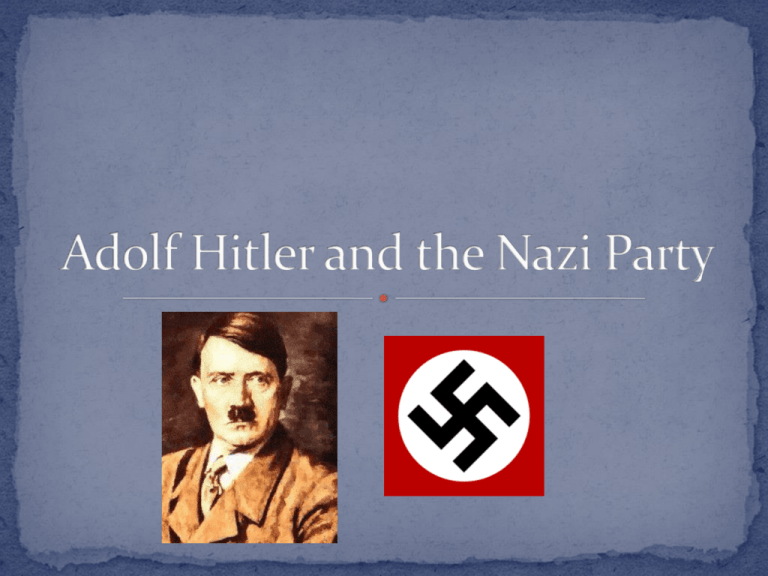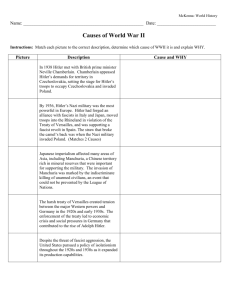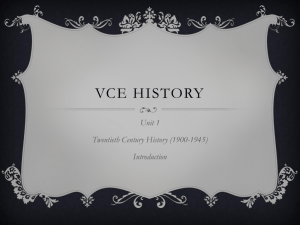Adolf Hitler and the Nazi Party's beliefs
advertisement

Adolf Hitler was born in the small town of Braunau in Austria on the 20th April 1889 to a customs official and a former servant girl He came from a Middle class family that was comfortable by the standards of the day The young Hitler had ability but performed poorly at school. He reacted against discipline and the conformity of school life: “What gave me pleasure I learned...what seemed to me unimportant or otherwise unattractive to me I sabotaged completely.” (A. Hitler, Mein Kampf, Manheim translation, Hutchinson, London, 1969, p.p 9-10 ) One of his former teachers described Hitler as “wilful, arrogant, and bad tempered. He had obvious difficulty in fitting in at school. Moreover he was lazy...he demanded of his fellow pupils their unqualified subservience, fancying himself in the role of leader.” (Quoted in A. Bullock, Hitler: A Study in Tyranny, Penguin Books, London, 1963, p.27) In 1905 at age 15, Hitler left school. Two years later he applied to the Vienna Academy of Arts but his application was rejected Later that year Hitler’s mother Klara died which affected him greatly In 1908 Hitler moved to Vienna, the capital of the AustroHungarian Empire In 1910, Hitler was unemployed and almost destitute, living at a shelter for homeless men. By 1910 Hitler began to show an interest in politics. By 1913 Hitler left Vienna and moved to Munich, the capital of the German state of Bavaria. In 1914 during WWI, Hitler joined the German Army Hitler served in the German Army on the front line in Flanders and France throughout the entire First World War Hitler showed bravery under fire, being awarded the Iron Cross Second Class in 1914 and the Iron Cross First Class in 1918 Hitler described the war as “the greatest and most unforgettable time of my life” In 1918 Hitler was caught in a gas attack and was partially blinded. He was recovering in hospital when he heard the news that Germany had surrendered. Hitler believed that Germany had been betrayed: “I staggered back to my ward and buried my aching head between the blankets and the pillow...during those nights my hatred increased, hatred for the originators of this dastardly crime.” According to Hitler’s own testimony, it was at this point that he decided to become a politician (Hitler, Mein Kampf, Manheim Translation, p. 176) After the war Hitler was made a political officer for the army While working, Hitler stumbled across a small, confused political group called the German Workers’ Party in September 1919 Hitler attended one of their meetings and spoke about issues he was passionate about. As a result, he was asked to join the party Hitler was put in charge of publicity and propaganda and from 1919 devoted all his energies to the party and sought to broaden its base and appeal During this time Hitler made several speeches and drew large crowds – the force of his personality, his organising ability and his powerful oratory ensured he became the dominant force behind the party The party changed its name to the become the National Socialist German Workers’ Party (National Sozialistische Deautsche Arbeiter Partei = NAZI) To give the party a distinct identity, it developed its own set of symbols and emblems, including the swastika, the party colours of black, red and white, and a distinctive party salute The Nazi Party also attracted more financial support and was able to create its own newspaper, the Volkischer Beobachter (National Observer) As the Nazi movement took shape it wished to promote itself as having a clear set of goals. Therefore, in February 1920 the party published its 25 Point Program, a wide-ranging statement about what the Nazis stood for. Political Parties Social policies -Nazism was against democracy, which was how the Weimar Republic operated -Nazism was based on nationalism and focused on restoring Germany’s national pride -Nazism supported totalitarianism because total power could be held in the hands of one person who ruled on behalf of the national interest -Nazism promoted the idea that the German people were a superior ‘Master Race’ – Hitler labelled this race Aryan -Hitler established several anti-Jewish policies, included the Nuremberg Laws, around the idea that the Jews were an inferior race polluting and destroying the Aryan Master Race Economic policies -The Nazis supported a particular brand of socialism – where all classes worked together in the national interest -However, they were against communism, which Hitler believed could only lead to the destruction of societies throughout the world. He believed that 75 per cent of all communists were Jews Agitation -The Nazis willingly used force to promote acceptance of and adherence to their policies -Bullying, threats and violence were all common features of Nazi rallies, speeches and publicity Hitler attempted to overthrow the Weimar Government in 1923 during the Munich Putsch He was put into Landsberg prison – but was released in 1925 Upon his release, his tactics changed: -Hitler learned that power could not be seized by force and that it had to be achieved legally – in 1933, ten years after the failed Munich Putsch, he did just that and was appointed Chancellor of Germany -The Munich Putsch gave Hitler and the Nazis national publicity he moved from being a relatively unknown politician in Bavaria to a national figure -Hitler learned that he could never hold power without the support of the army, which had not been prepared to support his putsch in 1923 While in prison, Hitler wrote his political autobiography Mein Kampf that outlined his political views He believed that: -Humankind was divided into racial groups – some were stronger than others -Germans were descended from Aryans – a master race that were blonde, blue-eyed, tall people only found in Northern Europe -It was the role of the Nazis to eliminate racial ‘pollution’ and return Germany to its rightful place as world leader -To remove racial ‘pollution’, he proposed that people with disabilities, hereditary disease or who were mentally ill be sterilised and that intermarriage with ‘lesser races’ like Poles, Czechs and Russians be stopped -The Jews were the greatest threat to the ‘master race’ because they controlled Communism, the world economy, the media, prostitution and crime – with world domination as their aim – thus denying Germany its destiny as leader of the world. After the failure of the Munich Putsch the Nazis were reorganised into a traditional political party Hitler tightened his control over the party in 1925– requiring all new members to swear lifelong loyalty to him The Nazis attempted to broaden their appeal by setting up new organisations targeting people from all walks of life (Eg: The Hitler Youth, the Nazi Women’s League and groups for doctors, lawyers, schoolteachers, factory workers and farmers) They also began a propaganda campaign – distributing posters, holding party rallies and giving speeches to broad audiences to win their votes in upcoming elections "Citizens! Do not believe that the Germany of misfortune and misery, the nation of corruption and usury, the land of Jewish corruption, can be saved by parties that claim to stand on a foundation of facts. Never!" This poster advertised a speech that Hitler was due to make in May 1920. Another early example of a Nazi poster, again inviting people to attend a speech by Adolf Hitler in Munich. The choice of colours here is deliberate. Red was believed to 'arouse the opponents' of National Socialism - and of course, is highly visible and therefore attracts more attention. 1921. A March 1933 poster. The text: “In the deepest need Hindenburg chose Adolf Hitler for Reich Chancellor. You too should vote for List 1.” Voting patterns – When did the Nazis have the least support? At what point did the Nazis have the most support? Why do you think this is so (you may want to consider what was happening in Germany at the time)? Date May 1924 Votes (in thousands) Percentage Seats in Reichstag Background 1,918.3 6.5 32 Hitler in prison December 1924 907.3 3.0 14 May 1928 810.1 2.6 12 6,409.6 18.3 107 After the financial crisis July 1932 13,745.8 37.4 230 November 1932 11,737.0 33.1 196 March 1933 17,277.0 43.9 288 September 1930 Hitler is released from prison After Hitler had become Chancellor






